I...Tree Roots
Tree Roots: Vincent van Gogh, Auvers-sur-Oise, July 1890, oil on canvas, 50.3 x 100.1 cm (Van Gogh Museum, Amsterdam)
Van Gogh had already made several drawings of tree roots in The Hague in 1882.
He wrote at the time of his wish ‘to express something of life’s struggle […] in
those gnarled black roots’. It is tempting to see the same symbolism in
these twisted tree roots, painted eight years later.
The work seems to consist at first sight of a jumble of bright
colours and abstract forms, prompting some art historians to identify
Van Gogh as an important forerunner of abstract art. If you keep
looking, however, you make out the tree roots, plants and leaves, and
beneath them the brown and yellow of the sandy forest floor, all laid
down on the canvas with powerful brushstrokes and oily gobs of paint.
Many people believe that the more dramatic Wheatfield with Crows
is Van Gogh’s final work. This colourful painting is a much likelier
candidate, however, as he was unable to complete it, which helps explain
its irregular, unfinished character. Theo’s brother-in-law, Andries
Bonger, described it as follows in a letter: ‘The morning before his
death, he had painted an underwood [sous-bois], full of sun and life.’
-- Van Gogh Museum
Tree Roots: Vincent van Gogh, Auvers-sur-Oise, July 1890, oil on canvas, 50.3 x 100.1 cm (Van Gogh Museum, Amsterdam)
Technique
must be born of inner necessity. When Van Gogh at one time, in order to
achieve the plastic character of the roots of a tree, squeezed oil
directly from a tube on his picture, it seemed to him the best means of
expressing what moved him at the moment in nature. That technique is the
best which permits the artist to express what he has to say as directly
and convincingly as possible.
-- The Materials of the Artist and Their Use in Painting, with Notes on the Techniques of the Old Masters: Max Doerner, 1934

Tree Roots: Vincent van Gogh, Auvers-sur-Oise, July 1890, oil on canvas, 50.3 x 100.1 cm (Van Gogh Museum, Amsterdam)
...The view is therefore bipolar: simultaneously that of the rabbit and the hawk. Colours -– wheat-gold, clay-brown -– tease the eye with possibilities of making sense of a field or a hill, but then scramble them into chaos. The usual aesthetic markers –- beauty and ugliness –- have been made meaningless. In Tree Roots the painted forms rap against the visual panes of our windows, as if trying to crash through the glass. In other paintings from these last weeks in Auvers the interior of the field –- green or gold stalks -– occupies the entirety of the visual field like a curtain. Without a beginning or an end this infinity of growing matter closes over us. It’s the ultimate compression of heaven and earth, a live burial within the engulfing sea of creation.
[This] may well be another view from inside Vincent’s hectic brain: all knots and strangling thickets, knobbly growths, bolting ganglia, claw-like forms, and pincers the look more skeletal than botanical... But this amazing painting – one of the very greatest (and least noticed) masterpieces from the founding moment of modernism -– is yet another experiment in the independent vitality of painted line and colour, as well as the uncontainable force of nature.
-- Simon Schama: on van Gogh's Tree Roots in Power of Art, 2006
Tree Roots: Vincent van Gogh, Auvers-sur-Oise,
July 1890, oil on canvas, 50.3 x 100.1 cm (Van Gogh Museum, Amsterdam)
II...Undergrowth with Two Figures

Undergrowth with Two Figures : Vincent van Gogh, Auvers-sur-Oise, July 1890; image by mbell1975, 5 May 2012 (Cincinnati Art Museum)
Then undergrowth, violet trunks of poplars which cross the landscape
perpendicularly like columns. The depths of the undergrowth are blue,
and under the big trunks the flowery meadow, white, pink, yellow, green,
long russet grasses and flowers.
-- Vincent van Gogh to Theo van Gogh and Jo van Gogh-Bonger, Auvers-sur-Oise, Wednesday, 2 July 1890

Undergrowth with Two Figures (detail): Vincent van Gogh, Auvers-sur-Oise, June/July 1890; image by hoobie 3, 16 March 2011 (Cincinnati Art Museum)
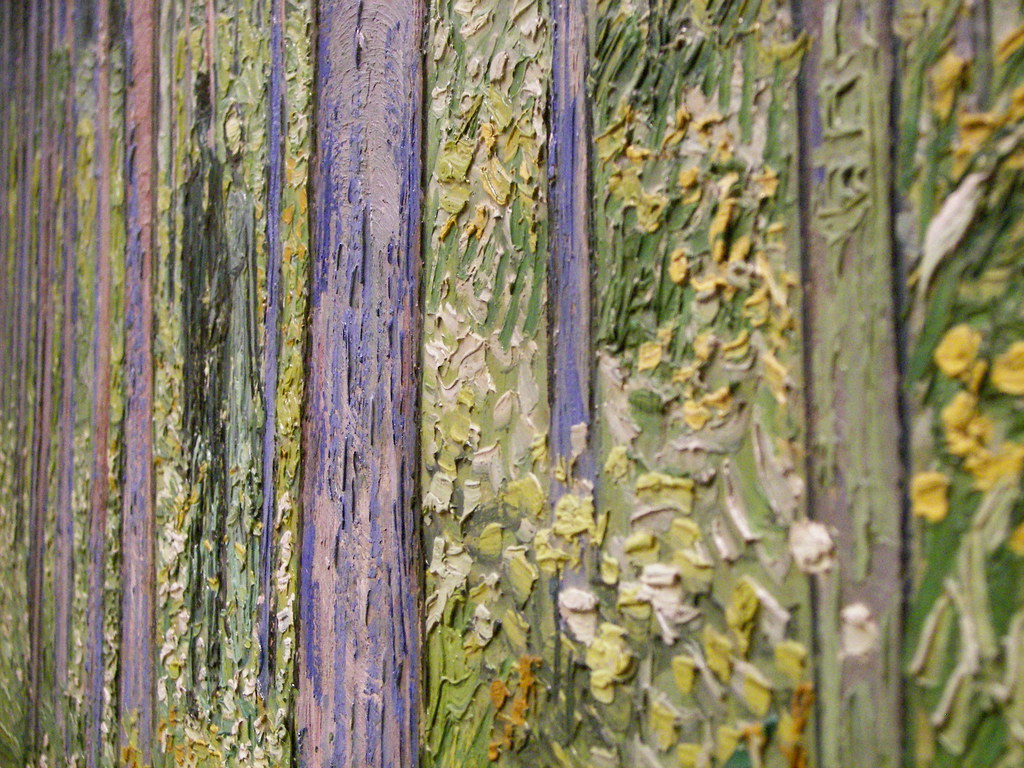
Undergrowth with Two Figures (detail): Vincent van Gogh, Auvers-sur-Oise, July 1890; image by Terri Viltrakis, 17 March 2007 (Cincinnati Art Museum)
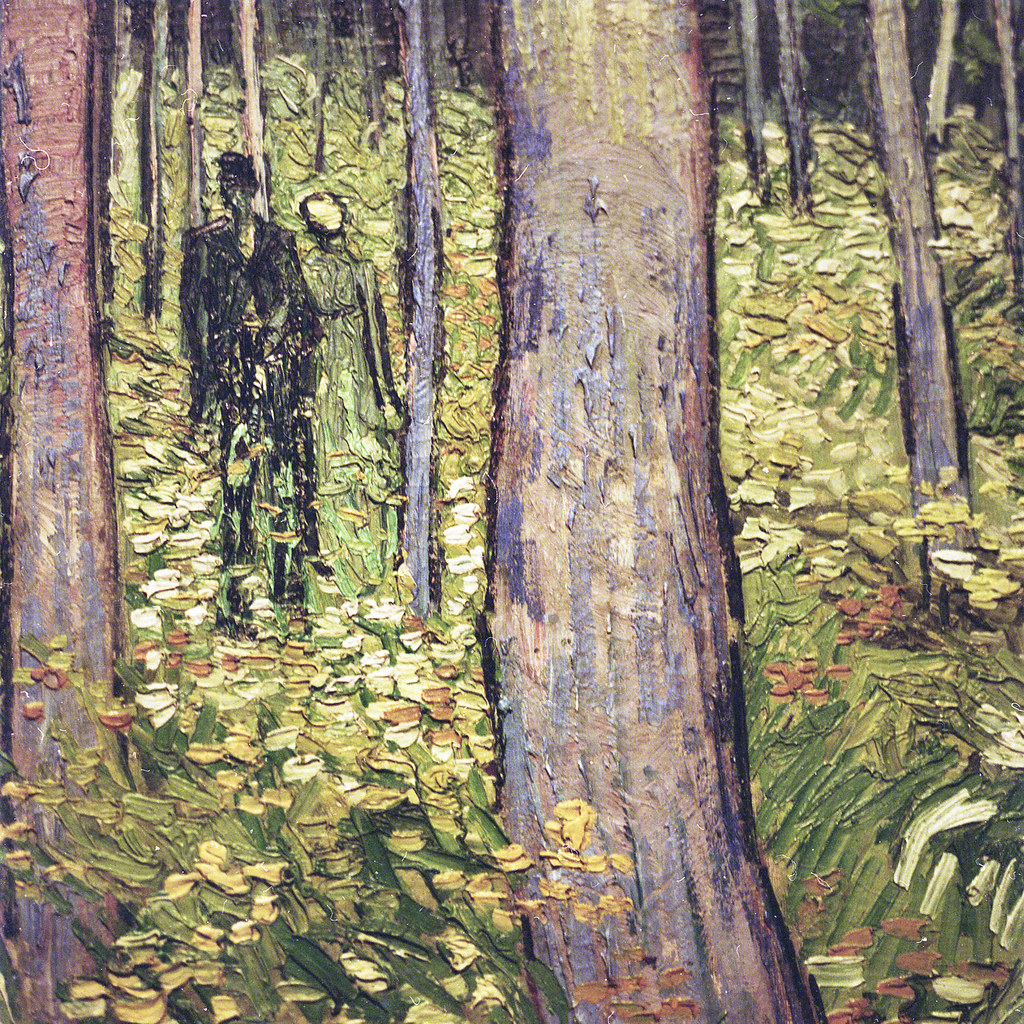
Texture of Undergrowth with Two Figures by Vincent van Gogh, painted June 1890, one month before his death: photo by erkaflugge, 2 April 2014( Cincinnati Art Museum)

Undergrowth with Two Figures: Vincent van Gogh. Auvers-sur-Oise, late June 1890, oil on canvas, 50 x 100.5 cm: photo by David Lewis-Baker, 24 April 2011 (Cincinnati Art Museum)

Texture of Undergrowth with Two Figures by Vincent van Gogh, painted June 1890, one month before his death: photo by erkaflugge, 2 April 2014( Cincinnati Art Museum)

Undergrowth with Two Figures: Vincent van Gogh. Auvers-sur-Oise, late June 1890, oil on canvas, 50 x 100.5 cm: photo by David Lewis-Baker, 24 April 2011 (Cincinnati Art Museum)
Van Gogh's brush strokes: Undergrowth with Two Figures, 1890 (taken at Cincinnati Art Museum): photo by elycefeliz, 4 February 2011
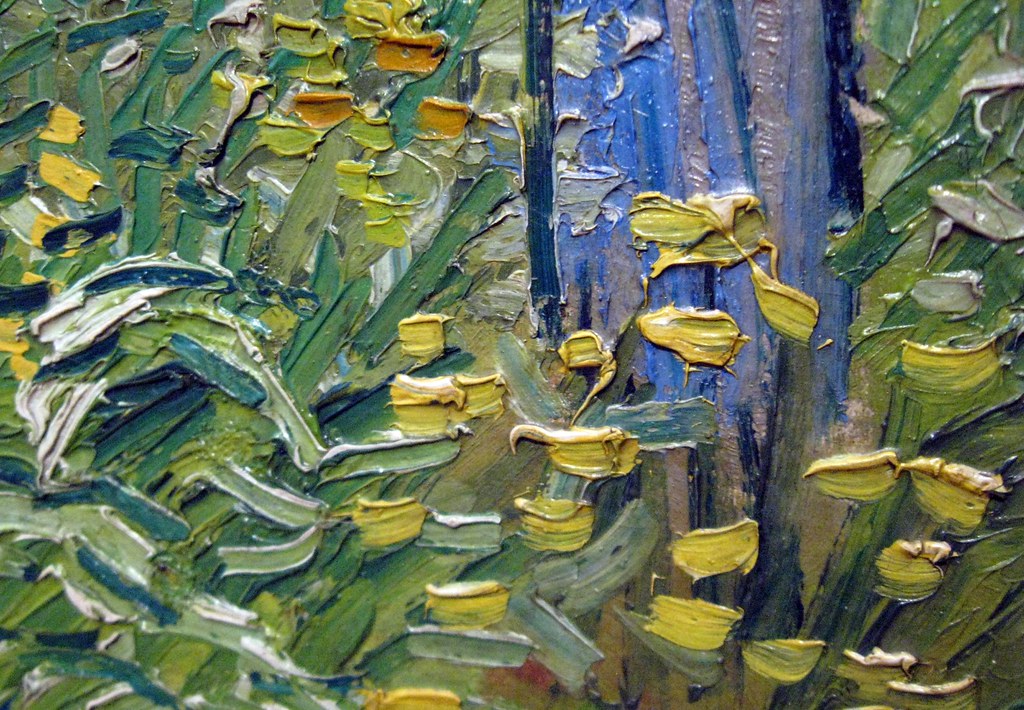
Van Gogh's Brush Strokes."The only time I feel alive is when I'm painting." Undergrowth with Two Figures, Auvers-sur-Oise, July 1890 (detail): photo by elycefeliz, 4 February 2011
Van Gogh's brush strokes: Undergrowth with Two Figures, 1890 (taken at Cincinnati Art Museum): photo by elycefeliz, 4 February 2011
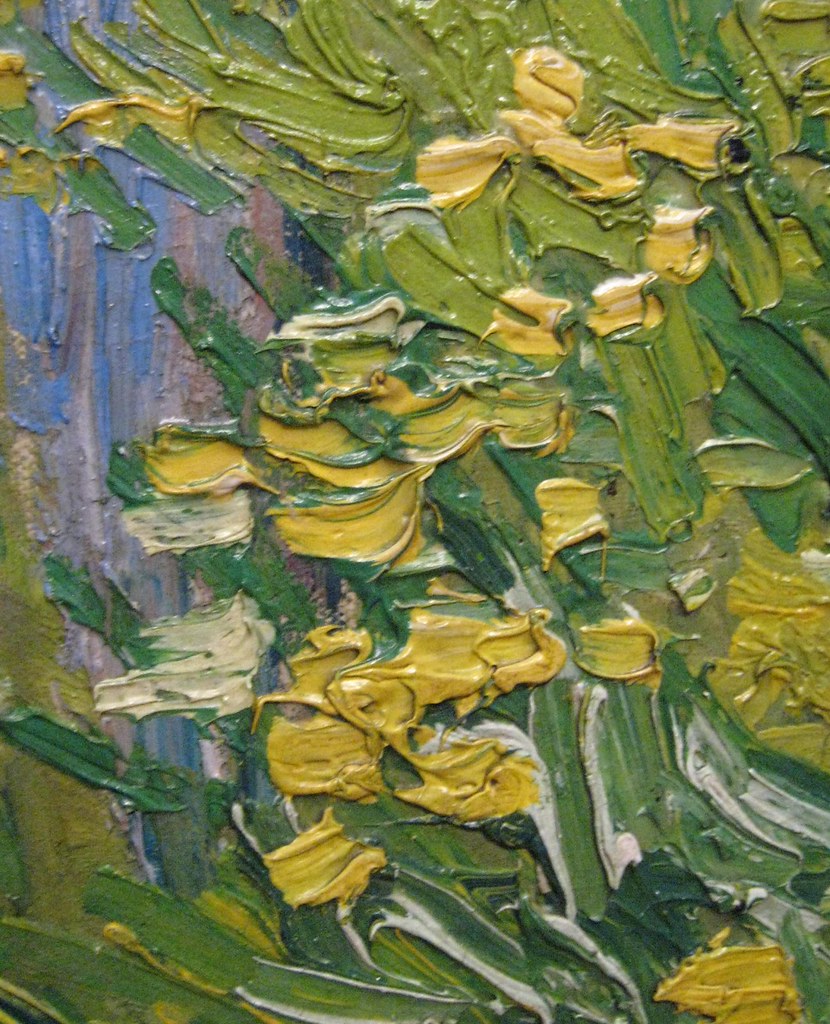
Van Gogh's brush strokes: Undergrowth with Two Figures, 1890 (taken at Cincinnati Art Museum): photo by elycefeliz, 4 February 2011
Van Gogh's brush strokes: Undergrowth with Two Figures, 1890 (taken at Cincinnati Art Museum): photo by elycefeliz, 4 February 2011

Undergrowth with Two Figures (detail of brushwork): Vincent van Gogh, Auvers-sur-Oise, June/July 1890; image by hoobie 3, 16 March 2011 (Cincinnati Art Museum)
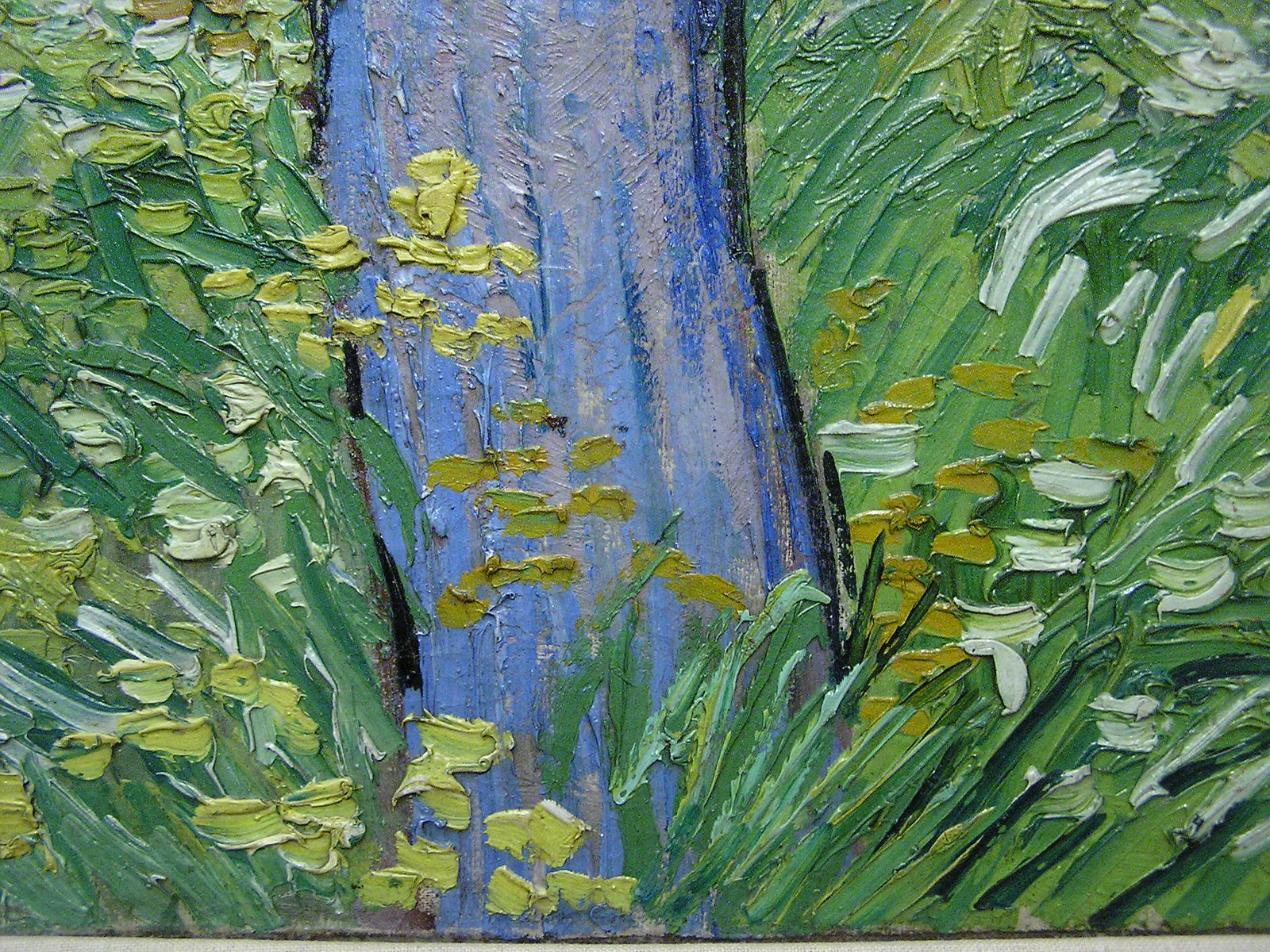
Undergrowth with Two Figures (detail of brushwork): Vincent van Gogh, Auvers-sur-Oise, June/July 1890; image by hoobie 3, 16 March 2011 (Cincinnati Art Museum)

Undergrowth with Two Figures (detail of brushwork): Vnicent van Gogh, Auvers-sur-Oise, June/July 1890; image by renzo dionigi, 10 November 2009 (Cincinnati Art Museum)

Undergrowth with Two Figures: Vincent van Gogh, Auvers-sur-Oise, July 1890; image by renzo dionigi, 10 November 2009 (Cincinnati Art Museum)
III...Bank of the Oise at Auvers
Bank of the Oise at Auvers: Vincent van Gogh, July 1890, Auvers-sur-Ois, oil on canvas, 74 x 94 cm (Institute of Arts, Detroit)
Van Gogh's Bank of the Oise at Auvers, detail (taken at Detroit Institute of Art): photo by Maia C, 3 September 2010
Bank of the Oise at Auvers (detail):
Vincent van Gogh, Auvers-sur-Oise, July 1890, oil on canvas, 74 x 94 cm
(Institute of Arts, Detroit); photo by ellenm1, 23 January 2010

Bank of the Oise at Auvers (detail): Vincent van Gogh, Auvers-sur-Oise, July 1890, oil on canvas, 74 x 94 cm (Institute of Arts, Detroit); photo by Martin Beek, 20 July 2014

Bank of the Oise at Auvers (detail): Vincent van Gogh, Auvers-sur-Oise, July 1890, oil on canvas, 74 x 94 cm (Institute of Arts, Detroit); photo by Martin Beek, 20 July 2014

Bank of the Oise at Auvers (detail): Vincent van Gogh, Auvers-sur-Oise, July 1890, oil on canvas, 74 x 94 cm (Institute of Arts, Detroit); photo by ellenm1, 23 January 2010
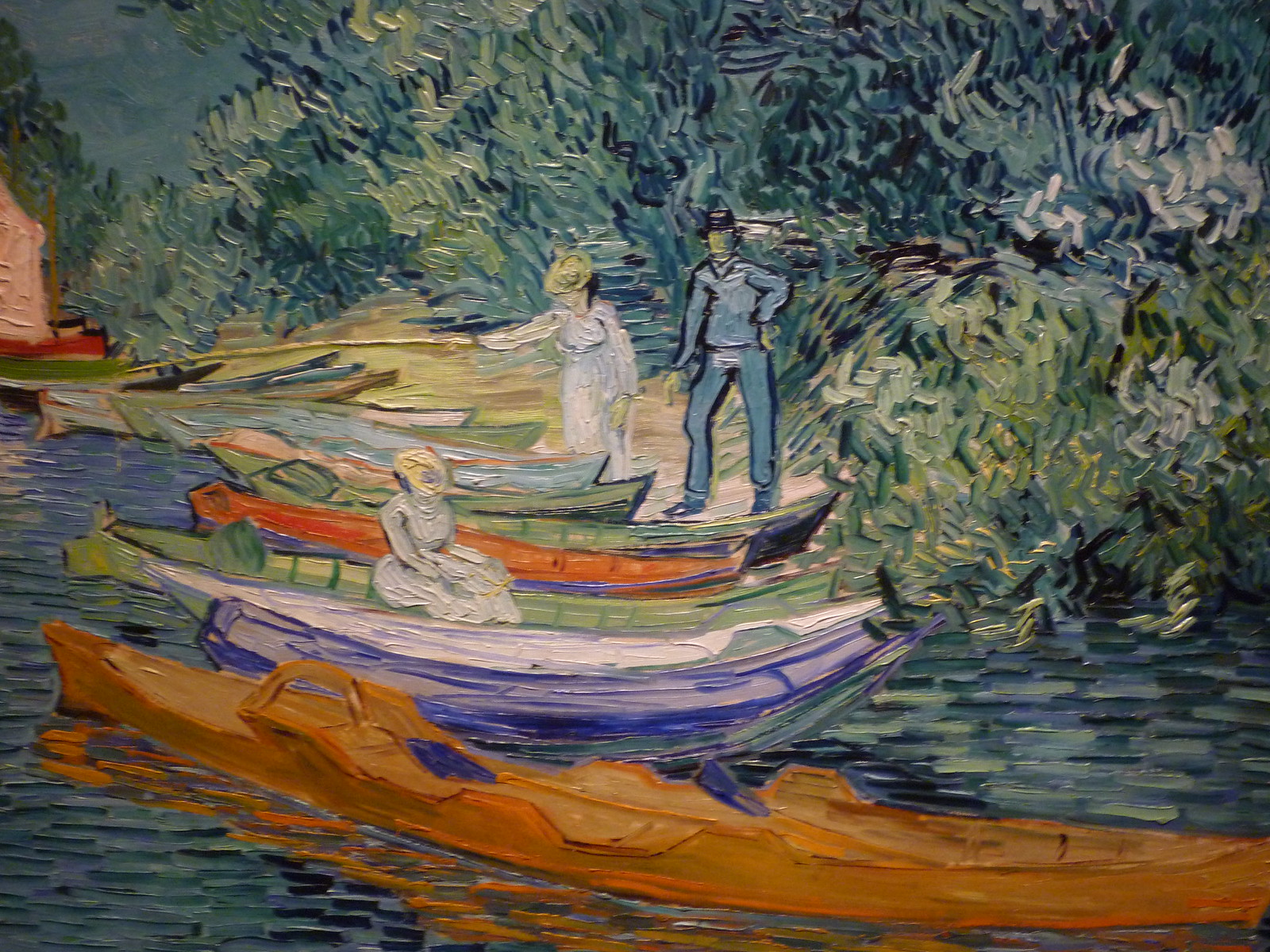
Bank of the Oise at Auvers: Vincent van Gogh, Auvers-sur-Oise, July 1890, oil on canvas, 74 x 94 cm (Institute of Arts, Detroit); photo by Quck fix, 6 July 2012

Bank of the Oise at Auvers (detail): Vincent van Gogh, Auvers-sur-Oise, July 1890, oil on canvas, 74 x 94 cm (Institute of Arts, Detroit); photo by Martin Beek, 20 July 2014
IV...Auxers and environs: views
Thatched Cottage in Cordeville: Vincent van Gogh, June 1890, Auvers-sur-Oise, oil on canvas, 73 x 92 cm (Musée d'Orsay, Paris)
Landscape with Carriage and Train in the Background: Vincent van Gogh, June 1890, Auvers-sur-Oise, oil on canvas, 72 x 90 cm (Pushkin Museum, Moscow)
Yesterday in the rain
I painted a large landscape, showing fields as far as one can see, looked at
from a height, different kinds of green growth, a potato field of a sombre
green, between the regular beds the rich violet earth, on one side a field
of peas in white bloom, then a field of clover with pink flowers and the
little figure of a mower, a field of long and ripe grass somewhat reddish in
tone, then various kinds of wheat, poplars, on the horizon a last line of
blue hills, along the foot of which a train is passing, leaving behind it an
immense trail of white smoke over all the green vegetation. A white road
crosses the canvas. On the road a little carriage, and white houses with
harshly red roofs by the side of this road.
Vincent van Gogh to his mother, on the painting Landscape with Carriage and Train in the Background, Auvers-sur-Oise, 12 June 1890:
Vineyards with a View of Auvers: Vincent van Gogh, June 1890, Auvers-sur-Oise, oil on canvas, 64 x 80 cm (Art Museum, Saint Louis)
The Church at Auvers: Vincent van Gogh, June 1890, Auvers-sur-Oise, oil on canvas, 94 x 74 cm (Musée d'Orsay, Paris)
V...Texture and Palette

Van Gogh texture (taken at Van Gogh Museum, Amsterdam): photo by zutaten, 30 October 2013
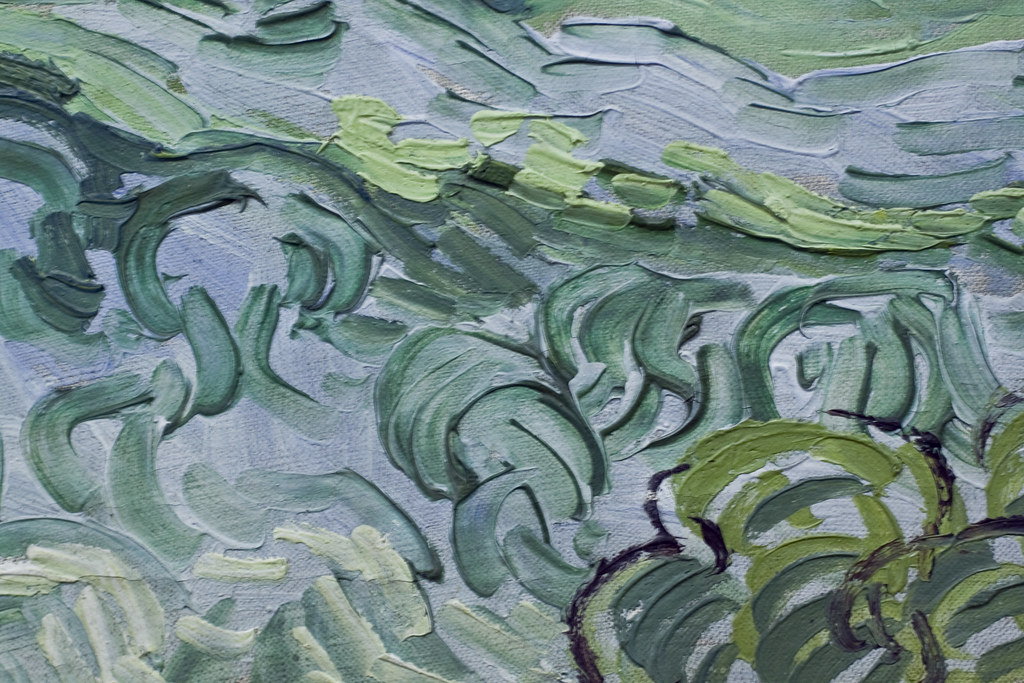
Van Gogh texture: photo by dacarrot, 23 June 2009
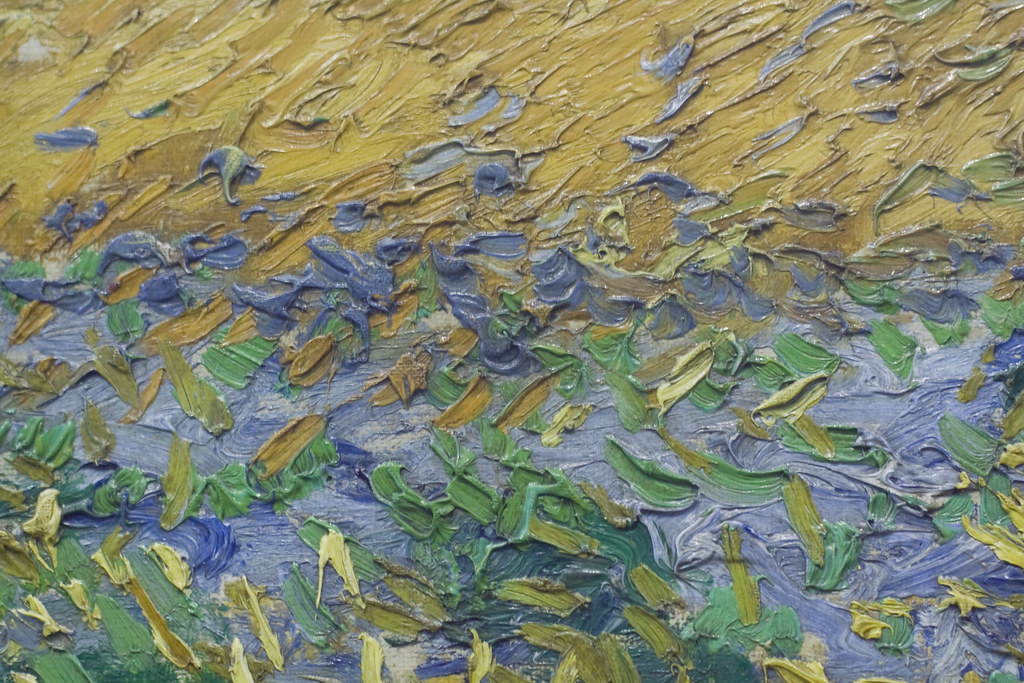
Van Gogh texture: photo by dacarrot, 23 June 2009
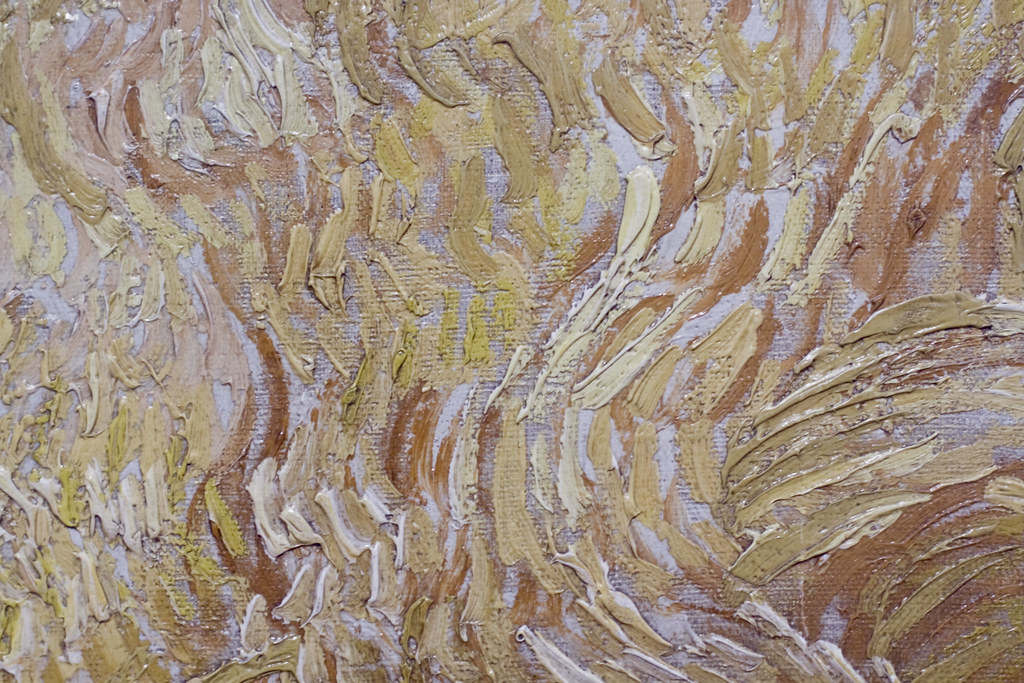
Van Gogh texture: photo by dacarrot, 23 June 2009

Van Gogh: detail of brushstrokes: photo by torpenhow3, 21 April 2011
Van Gogh's Wheat Field with Reape, detail (taken at Toledo Museum of Art): photo by Mario Q (aka MichSt), 9 February 2008
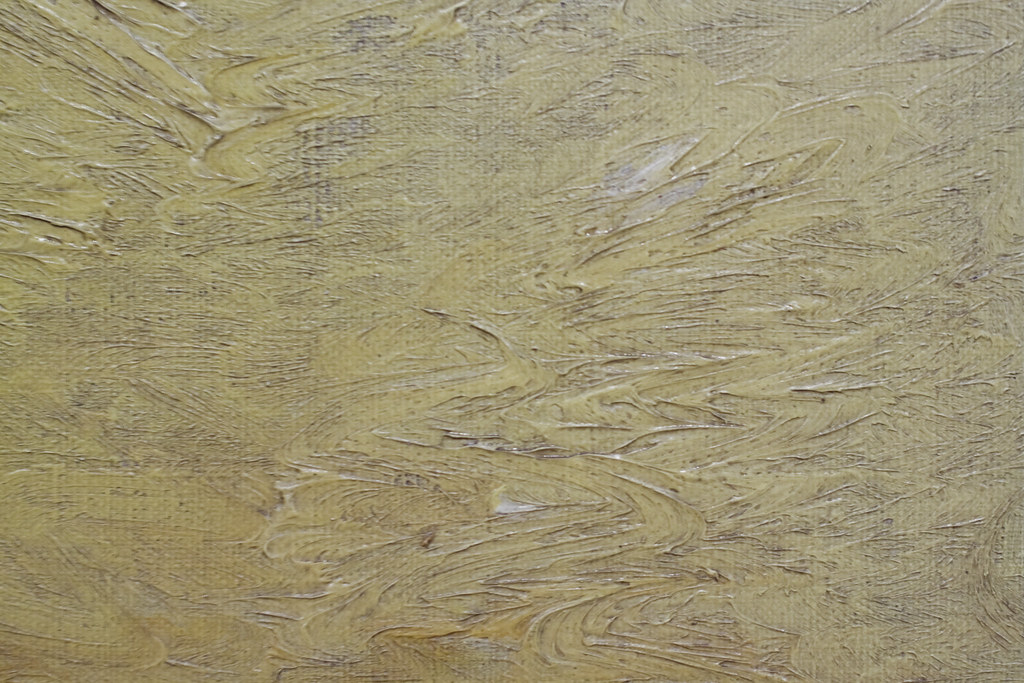
Van Gogh texture: photo by dacarrot, 23 June 2009
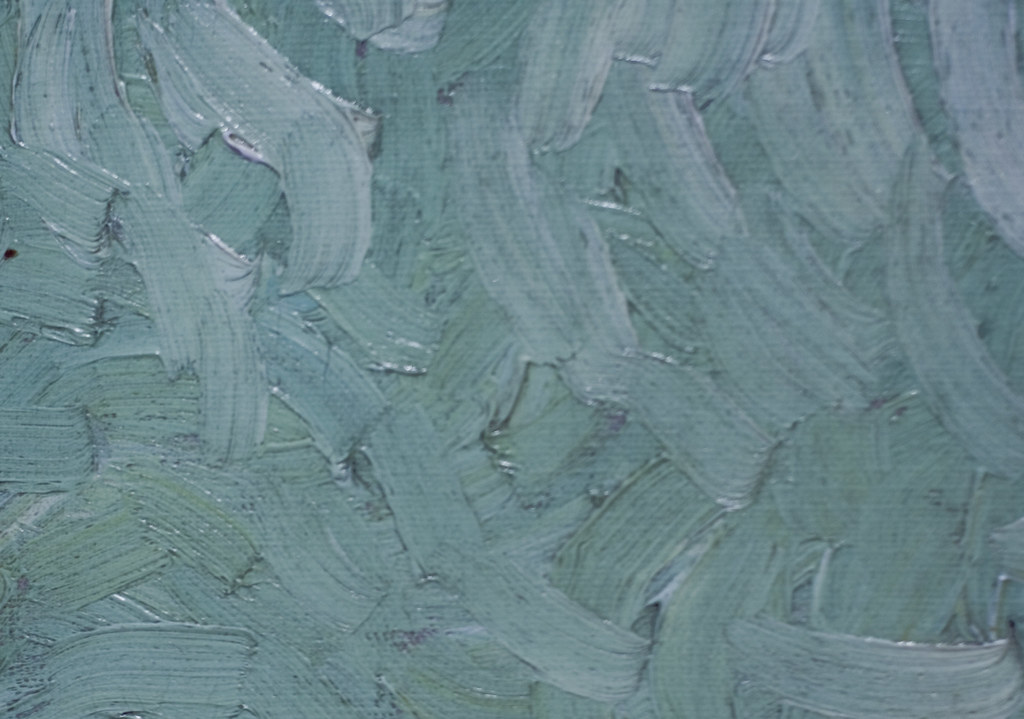
Van Gogh texture: photo by dacarrot, 23 June 2009

Van Gogh texture: photo by dacarrot, 23 June 2009
Van Gogh texture: photo by dacarrot, 23 June 2009

Van Gogh texture (taken at Van Gogh Museum, Amsterdam): photo by zutaten, 30 October 2013

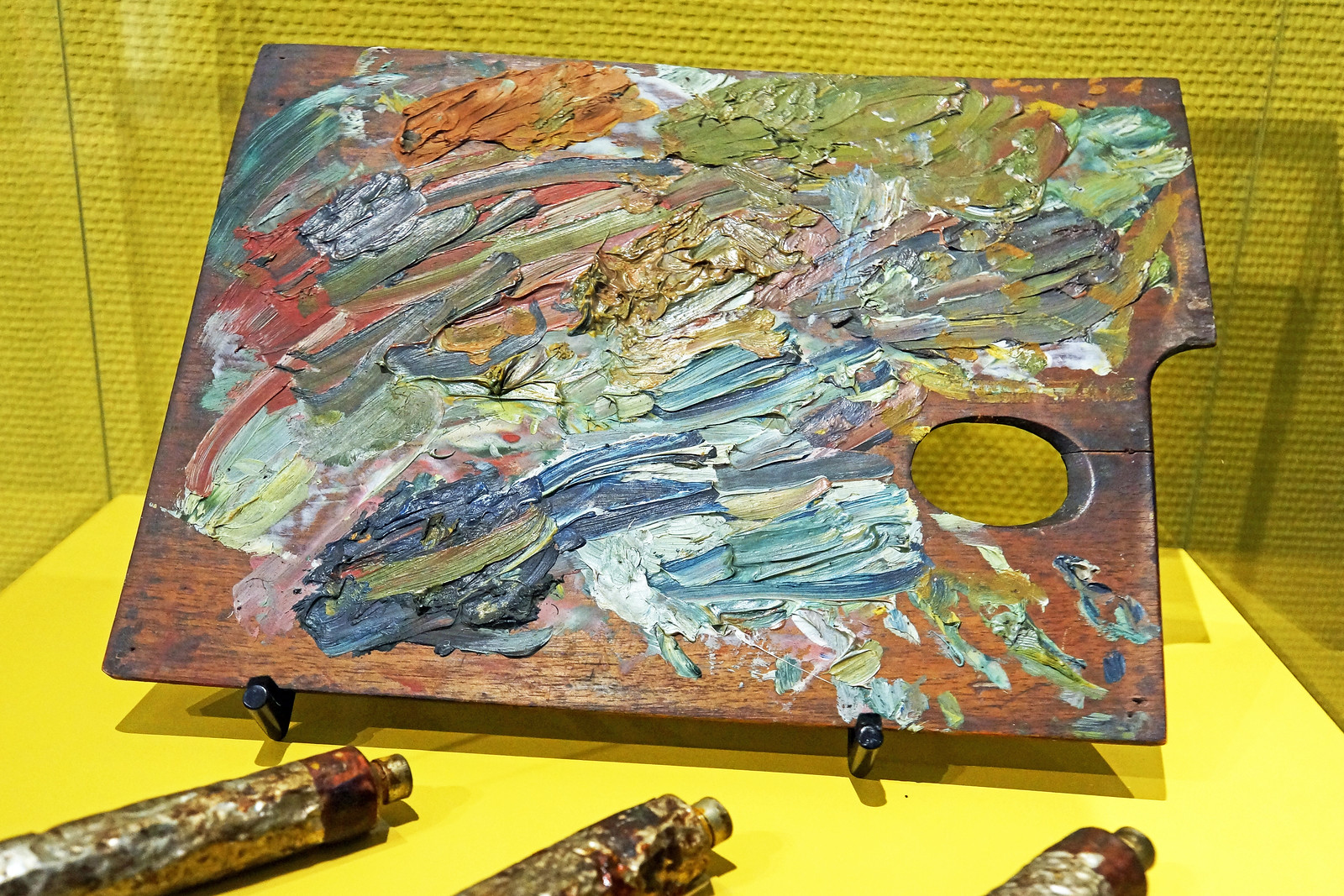
Vincent van Gogh's palette, with tubes of paint. "The only time I feel alive is when I'm painting.": photo by Dennis Jarvis, 20 September 2013
VI..."...that immense plain with wheat fields up as far as the hills, boundless as the ocean..."
Young Peasant Woman with Straw Hat Sitting in the Wheat: Vincent van Gogh, June 1890, Auvers-sur-Oise, oil on canvas, 93 x 74 cm (Private collection)
Young Peasant Woman with Straw Hat Sitting in the Wheat: Vincent van Gogh, June 1890, Auvers-sur-Oise, oil on canvas, 93 x 74 cm (Private collection)
Two Women Crossing the Fields: Vincent van Gogh, July 1890, Auvers-sur-Oise, oil on paper on canvas, 30 x 60 cm (MacNay Art Museum, San Antonio)
Wheat Field with Auvers in the Background: Vincent van Gogh, Auxers-sur-Oise, summer 1890, oil on canvas, 44 × 51.5 cm (Collection of the Musées d'art et d'histoire, Geneva)

House at Auvers: Vincent van Gogh, summer 1890, Auvers-sur-Oise, oil on canvas; photo by Frank Kovalchek, 28 October 2011 (The Phillips Collection, Washington D.C.)
House at Auvers: Vincent van Gogh, Auvers-sur-Oise, summer 1890, oil on canvas, 48.6 × 62.9 cm (The Phillips Collection, Washington, D.C)
Field with Wheat Stacks: Vincent van Gogh, July 1890, Auvers-sur-Oise. oil on canvas, 50 x 100 cm (Private collection)
Wheat Fields: The Plain of Auvers: Vincent van Gogh, June 1890, Auvers-sur-Oise, oil on canvas, 50 x 100 cm (Österreichische Galerie Belvedere, Vienna)
So -- having arrived back here, I have set to work again --
although the brush is almost falling from my fingers - and
because I knew exactly what I wanted to do, I have painted
three more large canvases. They are vast stretches of corn under troubled skies, and I did not have to go out of my way
very much in order to try to express sadness and extreme
loneliness. I hope you will be seeing them soon since I'd like
to bring them to you in Paris as soon as possible. I'm fairly
sure that these canvases will tell you what I cannot say in
words, that is, how healthy and invigorating I find the
countryside.
Vincent van Gogh to Theo van Gogh, Auvers-sur-Oise, c. 10 July 1890
Wheat Field with Crows: Vincent van Gogh, July 1890, Auvers-sur-Oise, oil on canvas, 50.5 x 103 cm (Van Gogh Museum, Amsterdam)
I myself am quite absorbed in that immense plain with wheat fields up as far as the hills, boundless as the ocean, delicate
yellow, delicate soft green, the delicate purple of a tilled
and weeded piece of ground, with the regular speckle of the
green of flowering potato plants, everything under a sky of
delicate tones of blue, white, pink and violet. I am in a mood
of almost too much calm, just the mood needed for painting
this.
-- Vincent van Gogh to his parents, Auvers-sur-Oise, c. 10-14 July 1890
Wheat Field under Clouded Sky: Vincent van Gogh, July 1890, Auvers-sur-Oise, oil on canvas, 50 x 101 cm (Rijksmuseum Vincent van Gogh, Amsterdam)
Our dear friend Vincent died four days ago.
I think that you will have already guessed the fact that he
killed himself.
On Sunday evening he went out into the countryside near
Auvers, placed his easel against a haystack and went behind the
chateau and fired a revolver shot at himself. Under the
violence of the impact (the bullet entered his body below the
heart) he fell, but he got up again, and fell three times more,
before he got back to the inn where he was staying (Ravoux,
place de la Mairie) without telling anyone about his injury. He
finally died on Monday evening, still smoking his pipe which he
refused to let go of, explaining that his suicide had been
absolutely deliberate and that he had done it in complete
lucidity. A typical detail that I was told about his wish to
die was that when Dr. Gachet told him that he still hoped to
save his life, he said, “Then I'll have to do it over
again.” But, alas, it was no longer possible to save
him….
On Wednesday 30 July, yesterday that is, I arrived in Auvers
at about 10 o'clock. His brother, Theodore van ghohg [sic], was there
together with Dr. Gachet. Also Tanguy (he had been there since
9 o'clock). Charles Laval accompanied me. The coffin was
already closed, I arrived too late to see the man again who had
left me four years ago so full of expectations of all
kinds… The innkeeper told us all the details of the
accident, the offensive visit of the gendarmes who even went up
to his bedside to reproach him for an act for which he alone
was responsible…etc…
On the walls of the room where his body was laid out all his
last canvases were hung making a sort of halo for him and the
brilliance of the genius that radiated from them made this
death even more painful for us artists who were there. The
coffin was covered with a simple white cloth and surrounded
with masses of flowers, the sunflowers that he loved so much,
yellow dahlias, yellow flowers everywhere. It was, you will
remember, his favourite colour, the symbol of the light that he
dreamed of as being in people's hearts as well as in works of
art.
Near him also on the floor in front of his coffin were his
easel, his folding stool and his brushes.
-- Emile Bernard to Albert Aurier, Paris, 2 August 1890
Landscape at Auvers in the Rain: Vincent van Gogh, Auvers-sur-Oise, July 1890, oil on canvas, 48.3 x 99 cm (National Museum of Wales)

Ears of Wheat (detail):
Vincent van Gogh, Auvers-sur-Oise, Summer 1890, oil on canvas; image by
marlie bouten, 29 June 2009 (Van Gogh Museum, Amsterdam)
The small attic room in Auvers-sur-Oise where Vincent van Gogh lived and died: photographer unknown, c. 1950s, via T. F. Simon: Vincent van Gogh and Auvers-sur-Oise
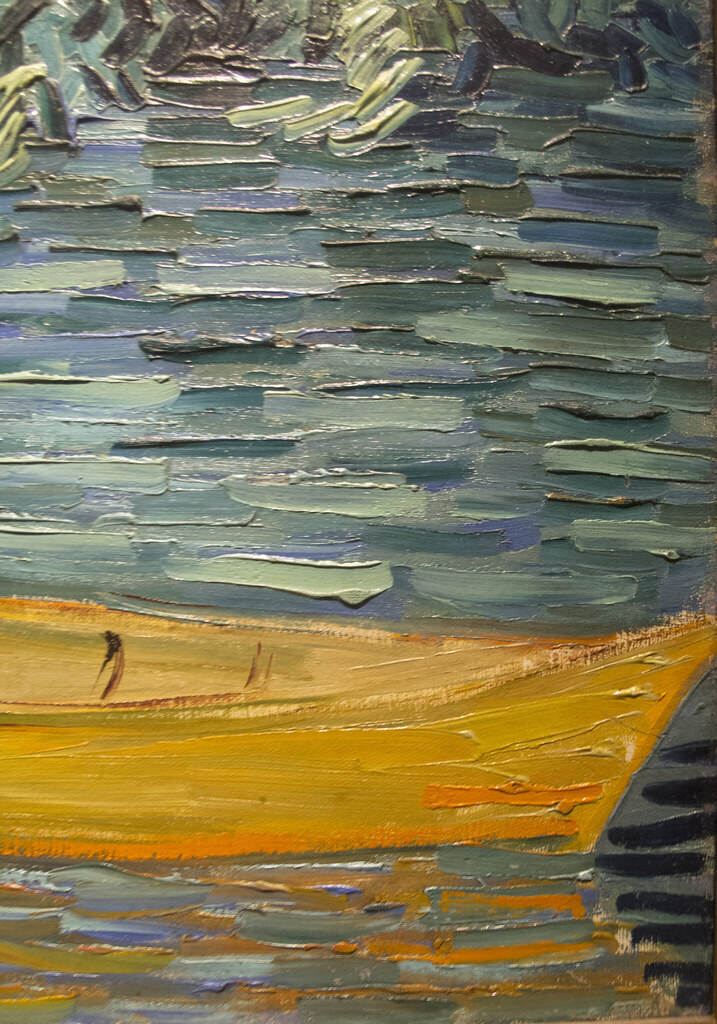
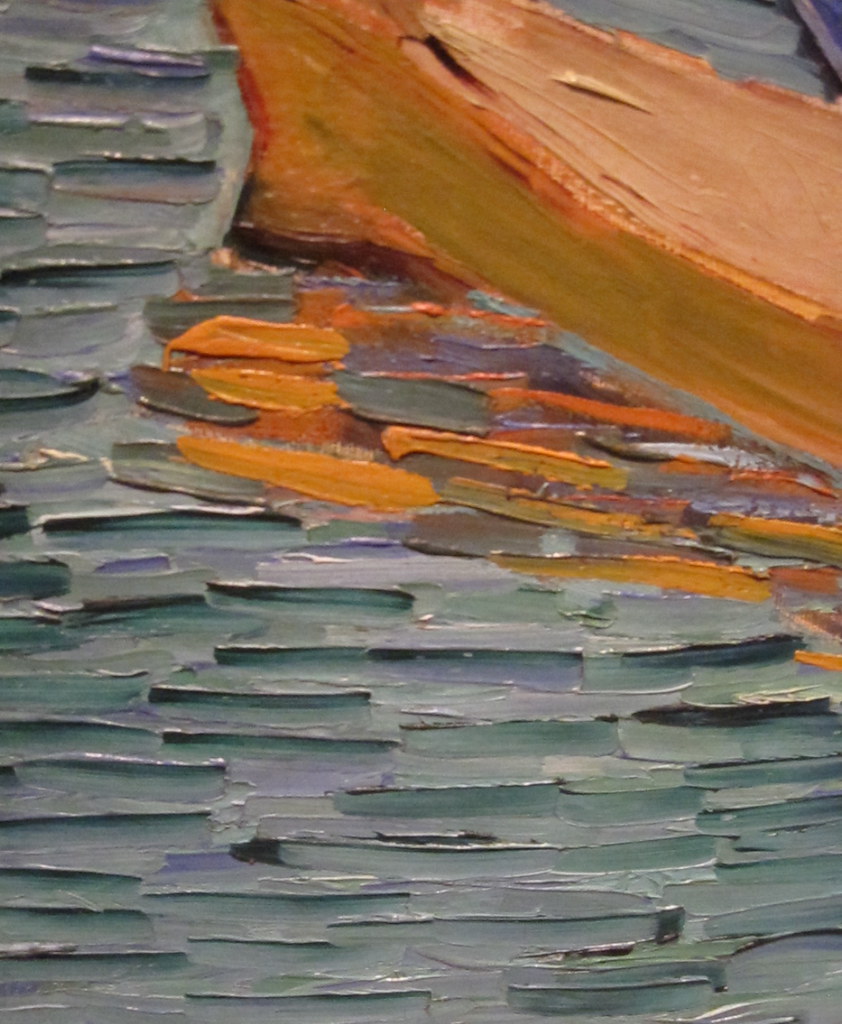
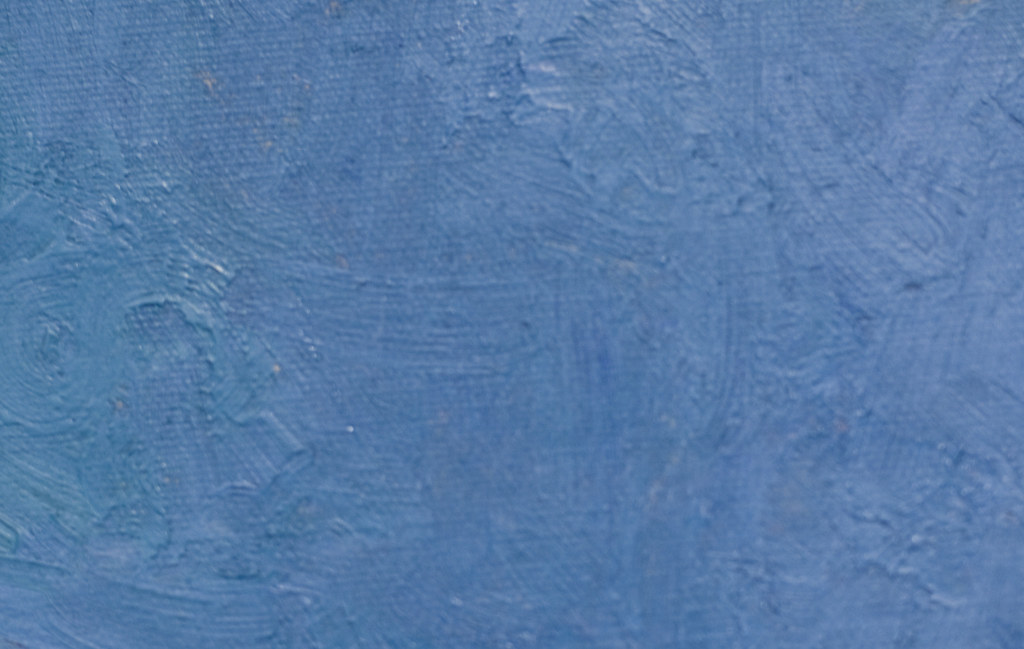
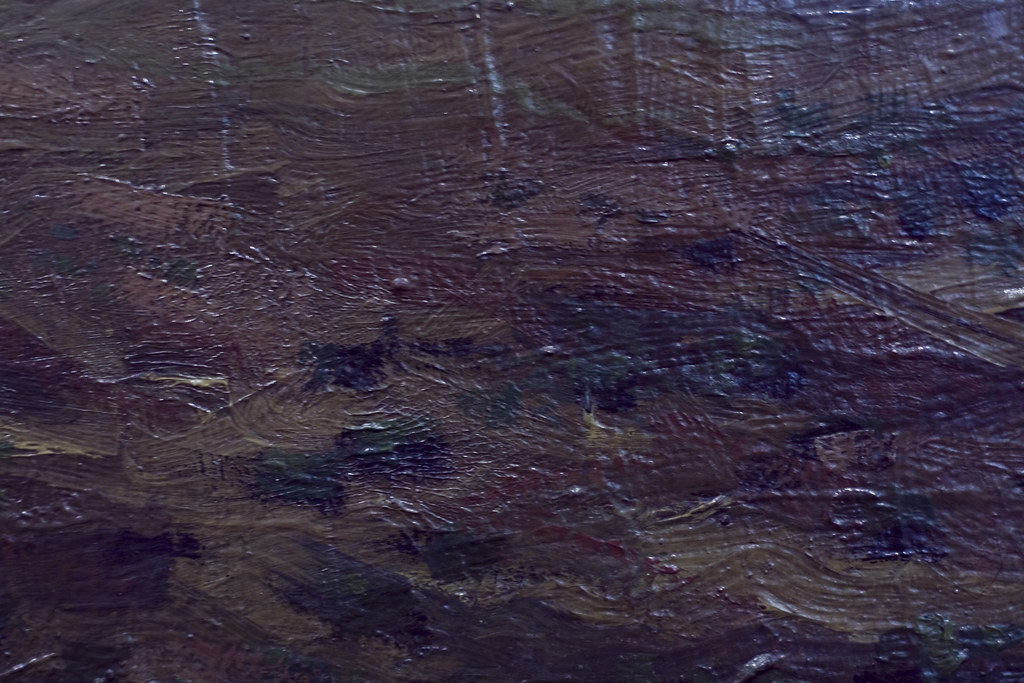
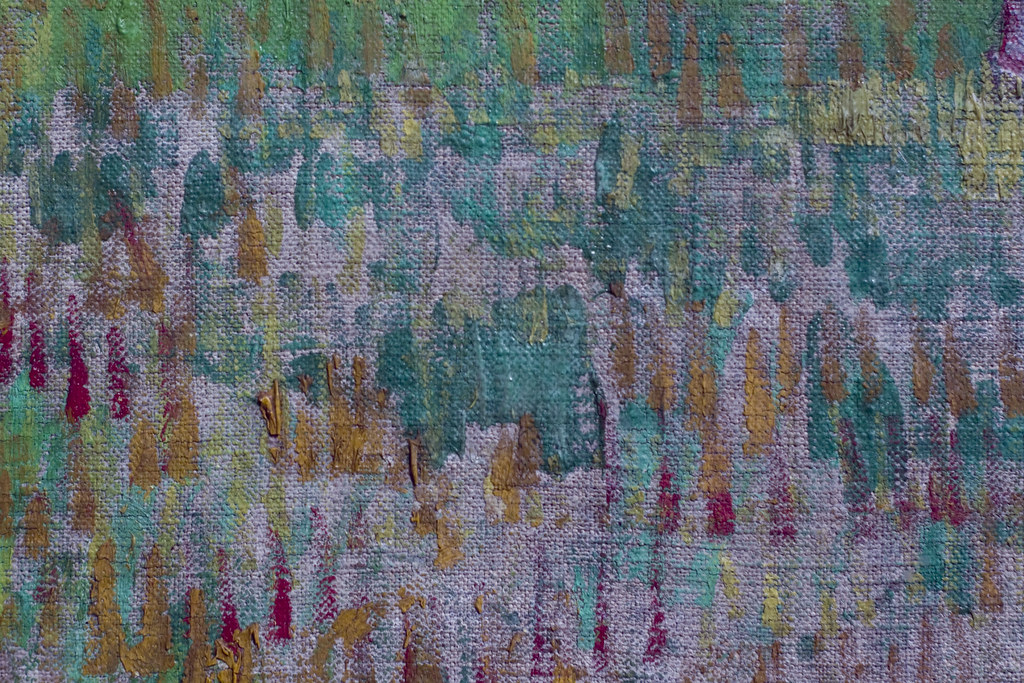
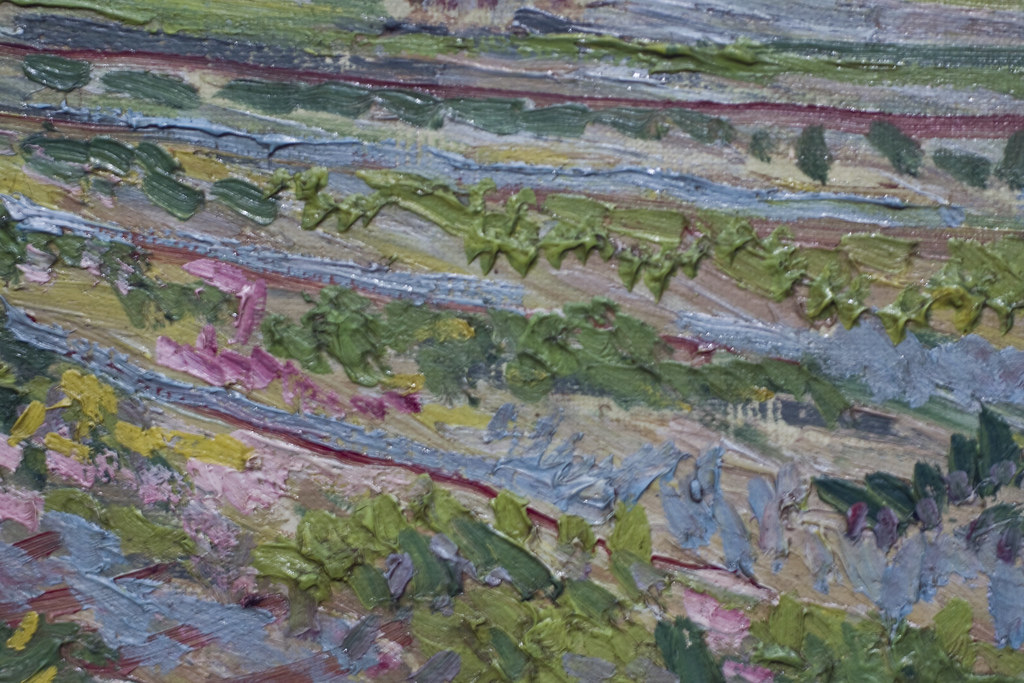
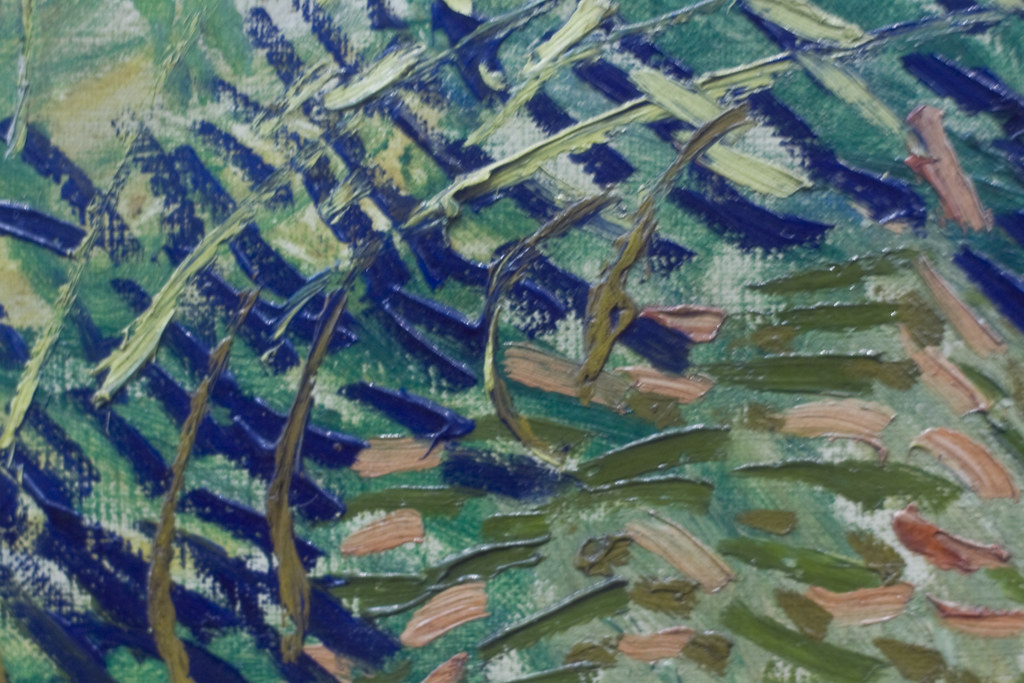



12 comments:
Stunning. So close to the brush strokes I feel I can step inside them, to another world separate from the image you see when stepping back. What a genius. His palette itself is magnificent.
There seems to be no end to the beauty, turbulence and serenity this blog brings into my life. Getting to view these gorgeous paintings that knock one off ones feet, like giant ocean waves, from so many perspectives, is wildly illuminating. You can see every twist and blob and dollop of paint, and how they all roil together. Exquisite color. The added texts and commentaries bring things further into focus emotionally, aesthetically. Better than a museum visit (the guards would NEVER let one get this close to the paintings!)
Many thanks, Hilton and Amy. Vincent is honoured, and loves you very much. And we're with Vincent on that. Everyone is invited to come right up close to the paintings. There's nothing so lovely as yellow-impasto-nose!
The people who managed to get up close enough to photograph the brushwork are our heroes of the day.
Just don't ever try that at the Met, kids.
But what goes in Detroit and Cincinnati -- different story, happily.
America was discovered so that everybody in it could think Vincent was nutty, just like them!
Ah, poor van Gogh! Never to escape the loony bin of received opinion! All the high-class pretend loonies wanting him to be strategically nutty just like them!
Mad posterboy for Depakote, flailing a wet paintbrush!
True fact btw... speaking of loony... we've got this extremely impertinent demented stalker/heckler troll who won't go away and thinks everybody's bipolar.
Every day in the comment box, a half dozen impertinent, personal, confessional, boastful, meretricious, abusive, ignorant, hateful -- and long! -- and really, really pretend-loony!! -- "comments".
They die in moderation. Our patience has worn thin. Moderation in all things hasn't worked. The demented comments keep on coming.
The last fourteen messages sent along by Crazy (to put a name on this curious alien life form) have constituted a sort of prolonged defense of schizophrenia, though nobody was asking, on grounds that, if you're rich enough, you can get away with acting-out in public.
Or as one of the missiles in today's salvo put it smugly --
"got tons of money in the bank and crazy is relative"
Und so weiter.
That's San Francisco for you, in a nutshell. Accent on the nut. (And the tons of money, of course.)
Only problem here, today, is, poor van Gogh, if the best he can hope for is to become just another mugshot in Crazy's rogue's gallery of artistic headcases. I was worried... Crazy's always here first thing... but then the day was saved. Hilton and Amy! Two terrific smart not-crazy poets! The joy!
We toasted Vincent and Hilton and Amy with a fortifying 40-litre slug of absinthe. We agreed all the best minds of every generation are the ones that have... uh. minds.
Sorry, Crazy, but when I think van Gogh, I don't think "nuts".
I think "genius".
And yes, Crazy, there's a difference.
In this last summer of his life van Gogh turned out a magnificently expressive painting almost every day. Working without "tons of money" and under intense pressure of self-demand, in a sort of darkling delirium
His breakthrough in learning to "stitch" canvasses, so that a 50 cm square turned into a 50x100 rectangle, was decisive.
Thus the wide wilderness of the wheatfields.
No one could produce work of such brilliance, so steadily, for long.
He'd never have been able to pull it off if he was what Crazy wants him to be -- just another garden variety headcase, with too much ambition, too much money, and too much time on its hands.
His painting always seems to me as deliberate and lucid is his choice to end his life.
There's a clear delight in the work at hand. The surface matters as much as what is seen. We need to come back to the paint, the colour densities and the traces of decision to save us from the mythic sludge that would preserve him as some kind of idiot savant.
You look through these images and begin to truly understand what makes Vincent a great painter.
I'm still dazzled by them now, two and a half years after beginning to study them.
The grand thing to take away from the letters, apart from the brotherly care, is the interest in the materials.
The working understanding of the paints and their properties, the variables of their application, the longevity, the treatment of the painting surface.
It's as in the relation between Turner and his father, perhaps, with the preparation of the canvasses -- these relationships of trust and mutual understanding, no nonsense, the materials, part of the work.
wonderful Van Gogh "No one could produce work of such brilliance, so steadily, for long"...agree !!
Thank you so much for this post, Tom! Those brush strokes are astounding. Definitely an argument for the material world.
A landscape poem from Turkey, in November of 2013:
There were chickens and geese
and strange pointy goose-tongues as
they hacked their greetings or
admonitions at us through the
fence
Then later sheep and straggly
odorless rose bushes and a
bright orange flower with
sheep in the distance
A bare and barren landscape
with dry grasses rough hedges and
bluish mountains in the distance
that Van Gogh with bamboo pens
and sepia and India ink could
bring to vibrant life with quick
stipple strokes and a thousand
heartfelt dots
Many thanks Sandra, Nora, Abdal-Hayy -- a thousand heartfelt dots connecting the countless billion loose ends of the material world, rubbing up together or flying past one another unnoticed, finally coming together, or falling apart, yet certainly and in any case getting on with the show, or else not, beyond all argument.
Vincent happy-happy today, we're all at the moment up in the imaginary tree house quaffing a tall cool beaker of lead paint spiked with absinthe in his honour.
And it's the very remedy for our queasy "public space" inbox this morning -- jammed as it is with yet more deranged "expert"-loony "I've got tons of money" psycho-blather, symptom postulation, limb-tip speculation, conspiracy theory, the shrink did it, the girl did it, the shrink was bipolar, or no everybody was bipolar, or else wasn't, and it's all so, like, unfair...
Victimology is endless, art eternal, there's a difference.
(The cats wisely decided to abstain from this congenial virtual-arboreal celebration, pleading extreme seniority.)
Thanks for this wonderful post, Tom. Have always wanted to see 'the undergrowth with two figures' which for some reason makes me think of:
I have come to take your place, sister,
At the high fire in the forest's heart.
Your eyes have grown dull, your tears cloudy,
Your hair is grey.
You don't understand the songs birds sing
Anymore, nor stars, nor summer lightning.
Don't hear it when the women strike
The tambourine; yet you fear the silence.
I have come to take your place, sister,
At the high fire in the forest's heart'...
'You've come to put me in the grave.
Where is your shovel and your spade?
You're carrying just a flute.
I'm not going to blame you.
Sadly, a long time ago
My voice fell mute.
Have my clothes to wear,
Answer my fears with silence,
Let the wind blow
Through your hair, smell of the lilac.
You have come by a hard road
To be lit up by this fire.'
And one went away, ceding
The place to another, wandered,
Like a blind woman reading
An unfamiliar narrow path
And still it seemed to her a flame
Was close..
In her hand a tambourine
And she was like a white flag,
And like the light of a beacon.
-----Anna Akhmatova
Was not overwhelmed by the paintings I saw in Amsterdam. Not sure if that was just fatigue (from waiting in a very long line).
A labor of love, Tom--thanks for admitting us into the delivery room.
Billoo and Vassilis,
Art and poetry thank you for your lucidity!
Vassilis, it was a home delivery, and the midwife is still gasping (though not so much from the proper labour of the occasion as from tending to the shrieking maniac in the comment-box lobby, who when last monitored was babbling on about Vincent's poor brother Theo being "probably bipolar too").
Billoo, I'm the same way about museums, or was, and I'm sure the lines are much longer now.
Post a Comment